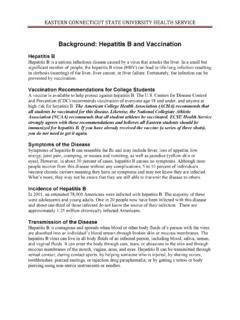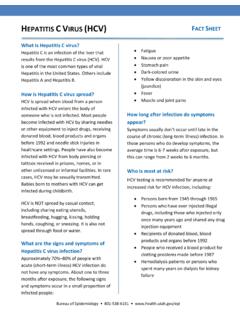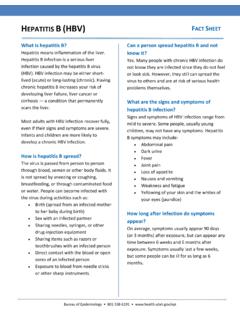Transcription of Fact Sheet: Hepatitis B in the WHO European Region
1 fact sheet WHO 2017 Hepatitis B in the WHO European Region Hepatitis B is a viral infection of the to serious complications such asliver cirrhosis and liver cancer. The virus is transmitted throughcontact with infected blood while usingunsterile needles or other medicalequipment; or through contact withcontact. infection. In the WHO European Region , 155mill ionpeople are estimated to be infectedwith Hepatitis B virus and 56 000 diefrom Hepatitis B-related liver diseaseeach year. which provides life-long protection. All children, as well as adults who are at risk of infection, should be vaccinated. the goal of elimination of viral Hepatitis July 2017 KEY FACTS AND FIGURESMore information: is Hepatitis B? Hepatitis B is caused by the Hepatitis B virus (HBV), which infects the liver and or chronic, and the associated illness ranges in severity from asymptomatic to symptomatic, progressive disease.
2 More than 90% of healthy adults who are however, children under 5 years of age who become infected with the virus, infection. How is it transmitted?In highly endemic areas, HBV is most commonly spread from mother to child at birth (perinatal transmission); it can also be spread from an infected to common in infants infected by their mothers or in children under the age of 5 is also spread during percutaneous or mucosal exposure to infected unvaccinated men who have sex with men and to heterosexual persons with multiple sex partners or contact with sex workers. The virus may also be transmitted by reuse of needles and syringes, either in health care settings or among people who inject drugs. Other routes of transmission are medical, surgical and dental procedures, tattooing and use of razors and similar objects contaminated with infected there a treatment?
3 Supportive care is used in symptomatic cases. Chronic HBV infection canbe treated with drugs, including oral antiviral agents, which can slow the progression of chronic disease and improve long-term survival. WHO recommends oral use of tenofovir or entecavir, which are also used fortreating HIV infection. These drugs rarely have side e ects and can e ectively control the virus. However most patients will require life-long treatment. How can Hepatitis B be prevented? in preventing HBV infection and its chronic consequences, including liver of Hepatitis B in many countries. By 2017, 49 of the 53 countries in the WHO European Region conducted universal HBV vaccination, but only 26 vaccinated all newborns, while the other 23 started vaccination at the age of 2 months or later.
4 WHO 2017 fact sheet Hepatitis B in the WHO European RegionVaccination of adults who are at high risk for HBV infection, including health care workers, can prevent transmission of HBV. Blood safety strategies, including qualit y-assured screening of all donated blood and blood components used for transfusion, safe injection practices and eliminating unnecessary and unsafe injections, can also protect against HBV transmission. Safer sex practices, including minimizing the number of partners and using barrier protective measures (condoms), also protect against B in the WHO European Regionpublic health problem. Worldwide, an estimated 257 million people are chronically infected. The major who become chronically infected; an estimated 887 000 people died in 2015 from chronic Hepatitis B.
5 Most people are unaware of their HBV infection and therefore often present with advanced disease. In the WHO European Region , approximately 15 million people are chronically infected with HBV, which leads to about 5 The epidemiology of Hepatitis B in the Region is diverse, with a prevalence of Hepatitis B surface antigen ranging from very low in the countries of western, northern and central Europe to intermediate and high in countries of eastern Europe and central Asia. The WHO global and regional responseWHO activities to prevent and control viral hepatiti s include: raising awareness and promoting partnerships; formulating evidence-based policy and data for action; promoting prevention of transmission by vaccination, safe injection practices and blood safety; and promoting wider access to monitoring, screening, care and treatment services for Hepatitis for the prevention, care and treatment of people living with chronic Hepatitis B national response to viral Hepatitis , including awareness raising, surveillance, prevention,laboratory capacity and guidance on testing and treatment, and is supporting regtional partnership European Vaccine Action Plan 2015 2020, which was endorsed by the Regional Committee in September 2014 year to increase awareness and understanding of viral



















